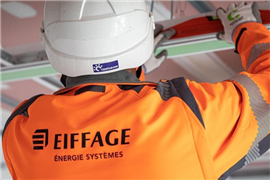Diving force - underwater demoltion solution
12 April 2011
TAI personnel were tasked with the removal of reinforced concrete structures from the bottom of the 8 m (26.3 ft) deep 20 m (66 ft) square concrete tank without causing damage to the tank itself or other immediately adjacent structures but also with a tight timeframe. These two considerations ruled out the use of heavy machine-mounted demolition attachments or hydraulic breakers because of vibration concerns. The tight timeframe also ruled out the use of pneumatic breakers because of the drop-off in performance this type of tool experiences under water (they lose 0.1 bar per metre). The structures involved consisted of reinforced concrete piles 2.5 m (8.2 ft) in length and 1 m (3.3 ft) in diameter.
As a result, a mix of hand tools wielded by divers were conserved the best option. The tools selected were a core drill and from Darda, a splitting cylinder and a combi shear.
Pile removal
Work commenced with a diver using the core drill to carry out drilling at preselected locations on the piles, with the resulting holes to be used as breaking points. Once the holes had been drilled the diver then inserted the 31 kg (68.2 lb) Darda C 12 N splitting cylinder into the resulting holes. The splitting cylinder consists of a main wedge and two counter wedges. Hydraulic pressure drives the wedge against the two counter wedges, causing them to be pressed with increasing force against the inner wall of the drill hole. The splitting force of 3,507 kN (358 tonne) that can be achieved by this hydraulic tool (provided via hoses from the surface) caused the concrete to fracture precisely at the point of the drill hole. In addition, the rebar within the structure at that point was either forced further apart and exposed or actually severed.
The diver then made use of a 14 kg (30.8 lb) Darda HCS 6 C combi shear to sever the remaining intact rebar, which consisted of rods from 6 m to 12 mm (0.25 to 0.5 in) in diameter. Using its shear set with a cutting force of 214 kN, this tool can easily cut rebar and round iron with a diameter of up to 18 mm
(0.75 in). The combi shear proved to be significantly faster and safer than the use of hydraulic angel grinders - because of an angle grinder's inherent rotation allied to poor visibility under water, their use is not recommended. Similarly, the use of burning tools under water to sever rebar is complex, inefficient and inherently hazardous.
Once the piles had been separated into suitably sized sections, these were lifted from the water by a truck crane. Once lowered to the ground, the sections were further processed using the splitter and combi shears to a size suitable for transportation.
The demolition of the concrete piles took just two days (16 working hours), including all preparation and follow up work.






